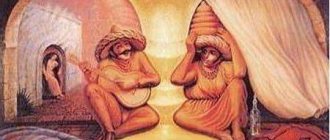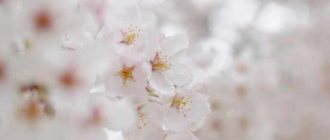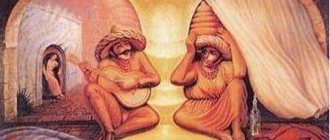Article for the "bio/mol/text" competition: Few people know that the biophysics of sensory systems has its own name - psychophysics. One of its most interesting areas is the psychophysics of color. Color is a property of objects in the material world, perceived as a conscious visual sensation. This or that color is “assigned” by a person to objects in the process of their visual perception. This is successfully used by advertising agents all over the world. Create an advertisement, a sign so that people remember it and attract customers? Easily! Remember that when you mention a product, store or establishment, you immediately imagine its color scheme, used in advertising, in a logo or in packaging. This article explains why we are so sensitive to color advertising.
Color perception - how does it function?
Color perception is one of the functions of vision, thanks to which a person perceives the world in all its variety of colors and shades. The refractive system of the eye and the retina, on which light rays are collected after refraction by the lens and cornea, are responsible for image formation. The color of the picture is determined by the central point of the retina - the macula, or more precisely, the cones. These photoreceptors provide color vision and are involved in photopic (daytime) vision.
There are three primary colors in nature: red, green, blue. The entire variety of shades, of which there are several tens of thousands, is formed by mixing these three main tones. This theory was put forward by Lomonosov in 1756. T. Jung conducted his research in the same direction. Subsequently, the idea of three-component color perception was supplemented by G. Helmholtz and his students. There are three types of cones, each containing a specific pigment. In other words, the macula contains blue, red and green cones. In this case, color waves, regardless of their length (spectrum), immediately affect the entire cone apparatus. If there are any defects in it, the color perception will be incorrect. In this case, we are talking about color vision disorders. They are caused by pathologies of the optic nerve, retina, and nervous system.
Color vision disorders are rare. Approximately 8% of all men have congenital impairments of this visual function, but this does not mean that they cannot distinguish colors at all. In most cases, one of the spectra is not available to them. In women, problems with color perception are even less common (approximately 0.5% of cases). Color vision disorders can create some difficulties when choosing an activity. Information is often presented in the form of color signals - in transport, industry, agriculture and other areas.
What's inside?
What happens in the body itself when we see any color? How does our brain react to the colors of the world around us? It turns out that the outer segments of the rods of the retina of humans, marine invertebrates, fish and almost all terrestrial vertebrates contain a basic visual pigment called rhodopsin. It is also called visual purple because it becomes purple in color after absorbing green or blue light.
See also: “Visual rhodopsin is a receptor that responds to light” [8].
Rhodopsin best absorbs light wavelengths of 500 nm, while the absorption of color-sensitive cone pigments of various types occurs in the region of 420 nm (blue light), 531 nm (green) and 558 nm (red). When light is absorbed, the conformation of the protein part of rhodopsin changes, and it activates the G-protein transducin, which triggers the enzyme cGMP phosphodiesterase. As a result, the concentration of cGMP in the cell drops and sodium channels close. As sodium ions are constantly pumped out of the cell by ATPase, their concentration within the cell rapidly drops, causing hyperpolarization of the visual membrane. As a result, the photoreceptor releases less of the inhibitory transmitter glutamate, and nerve impulses arise in the bipolar nerve cell, which is “disinhibited.”
See also: “Receptors in active form” [9].
This is why colors with longer wavelengths have the greatest impact. For example, red has the longest wavelength. An exciting, warming, active and energetic color, it penetrates and activates all body functions: stimulates nerve centers, energizes muscles.
Of course, many epithets here should be taken purely figuratively. - Ed.
Blue color, on the contrary, has the shortest wavelength - therefore it calms and slows down the body's nervous system. Recommended in therapy for emotional and nervous people, however long-term exposure to blue can lead to depression.
The influence of color on a person
Today, psychologists also study the problem of the influence of color on humans. From their point of view, certain shades carry emotional information and, therefore, participate in the formation of mood. Such data can be used to make your image more attractive, your environment more comfortable, and your products and services more salable. Colors can be used in the treatment of diseases of the nervous system, in marketing and other areas. Many people are skeptical about this. Indeed, such theories are difficult to study and cannot always be scientifically proven. However, they should not be completely rejected. Let's find out what they are, how colors influence a person and his life.
Visible light
The human eye perceives a rather narrow range (380-780 nm) of all electromagnetic radiation:
Spectrum of radiation visible to the human eye.
A prism refracts light and separates it into colors.
We do not see radiation outside our perception, but we can feel it with other senses. Ultraviolet is tanning and sunburn, infrared radiation is heat from heated things and the glow of hot objects.
Ultraviolet bath and a crowd of people in infrared.
Features of color perception
Human perception of color is subjective. Some people like warmer shades, others prefer cool tones. Moreover, the same color can be perceived differently by people. Of course, there are general patterns. So, according to survey results, most people love the color blue. Why him? What determines the choice of shade?
There are three theories to explain this issue:
- evolutionary;
- theory of gender schemas;
- ecological valence theory.
What is the essence of each of them?
Biology or evolution. According to this theory, biological mechanisms formed during evolution determine human color preferences. So, initially the color blue was associated with the night, and therefore with calmness and passive pastime. Yellow hues, which resemble the sun, correlated with activity. Why, then, do men like blue and women like pink? These differences were caused by evolutionary changes that occurred during the times of gathering and hunting. In the early era, women had to cook food and pick fruit. They are mostly red and yellow and stand out well against the green foliage. It is for this reason that the fair sex prefer all kinds of shades of red and yellow. Proving this theory is quite difficult. The other two hypotheses explaining color preferences look more convincing.
Gender schema theory. The formation of color preferences is influenced by gender. This is what the supporters of this theory say. From a psychological point of view, color perception is established in childhood, as soon as the child begins to realize his gender identity. After this, they search the world for information, including colors, that is associated with their gender. Parents reinforce gender stereotypes. They dress boys in blue or dark colors, girls in pink. Because of this, girls subsequently gravitate towards this color, and guys towards blue. A study was conducted in which specialists observed children from 7 months to 5 years. The boys became more and more distant from pink tones the more they learned about their own gender. The same pattern was found among girls. They increasingly preferred pink shades.
Ecological valence theory. The previous concepts partially explain people's color preferences. But these theories are general. They are not able to answer the question why a person loves dark blue, light blue, soft pink and other shades. Where does such a variety of tastes come from? The theory of ecological valence tried to answer this question. According to her, color perception is formed on the basis of emotional experience. A person will like more those shades that he associates with something positive, joyful, and pleasant.
To prove this theory, scientists conducted a study. In it, subjects were offered two pens of different colors with musical accompaniment. One color was accompanied by unpleasant music, the second by positive music. Most people chose pens that were associated with good music. The advantage of this theory is that it does not reject the ideas of its predecessors who formalized the theory of gender schemas. Please note that boys are often given blue toys, and girls are given pink ones. Toys evoke positive emotions. In the future, color will only be associated with good things. According to the ecological valence, which gave the theory its name, we understand the ability to adapt to environmental factors.
Orange
In psychology:
Positive characteristics:
The color of friendliness and optimism, joy, enthusiasm, creativity, success, encouragement, change, determination, health, stimulation, happiness, fun, pleasure, balance, freedom, self-expression and charm.
Negative characteristics:
high self-esteem, extravagance.
In Vedic astrology (Jyotish):
Orange refers to the planet Sun. Day of the week is Sunday.
Connection of color with chakra:
The 2nd chakra Svadhisthana (sexual chakra) glows orange. Responsible for contact with the opposite sex, pleasure. Located below the navel. To harmonize the 2 chakras, it is recommended to engage in creativity, learn to be harmonious, and eat a balanced diet.
Clothing preference:
Stylists recommend using dark shades of orange; it goes well with brown, red, beige, and black.
Scientists say that if you look at the color orange for a long time, it will replenish your daily dose of vitamin C.
Psychologists recommend that people prone to depression wear orange as the color of joy, positivity, activity and enthusiasm.
It is important to note that orange is not only the color of joy and positivity. Buddhist monks wear orange (saffron), as it is the color of renunciation of evil desires, greed, and anger.
In the interior:
Orange color in the interior always helps to create a joyful, soft atmosphere in the house. Orange color has a good effect on the human psyche, stimulates him to be decisive, active, and optimistic.
Good for children's room, kitchen. Goes great with pale yellow, pink, green, red.
Color therapy:
Considered the color of energy. The color of the Sun gives beauty, energy, cheerfulness, and health. Improves blood circulation, digestion, stimulates the activity of the sex glands, relieves emotional blocks and depression. In psychotherapy it is considered one of the most beneficial flowers.
Human perception of colors and their meanings
The emotional background that surrounds a particular shade can be explained by the theory of environmental valence. However, it is powerless in understanding the problem of the semantic meaning of color. Why is each of them associated with something? For example, red - with passion? The theory of associative networks provides answers to such questions. A network of interconnected knowledge develops in the brain over the course of a person’s life. They are based on emotions, sensory experience and semantic meaning. In this theory, these factors are called “nodes”. Each color has its own node in the brain. It can change over the course of life, that is, as a result of gaining new experiences. Important events form strong knots. So, for example, if a person was hit by a red car, a node of this particular tone will form in the head. It will be associated with certain emotions. Subsequently, other feelings may be added to them.
Psychologists often assign color one meaning or another. Blue is considered calm, black is down-to-earth, and yellow is cheerful. Actually, this idea of colors is common to many, but color psychology itself is not so simple. There is no single meaning that would describe color as completely and succinctly as possible. People can attach completely different conflicting meanings to a particular shade based on their own experiences. For example, funeral service workers are accustomed to being among black objects. It is not surprising that they associate them with grief. People who like to ski perceive the color white positively. It is associated with snow and the pleasant emotions received during skiing.
These are not all the factors influencing the perception of color. Culture plays an important role in this. There are some regularities: in the West, people prefer blue. In the East, this same color is perceived as cold; it is associated with negativity and even evil. Many peoples of Africa perceive white as a negative color, while black, for obvious reasons, is preferable for them.
There is another significant factor - context. In everyday life, many people associate the color red with passion. During the years of revolution, red tones symbolize the blood shed by the people. Why is it important to study such questions? How can this information benefit you?
Firstly, it will be easier for each person to organize their workspace or everyday life. Knowing your color preferences and the tastes of your relatives, you can create a more comfortable atmosphere at home. Secondly, studying color perception can be useful in marketing. Before you start selling your product, research your target audience. When selling pots and pans, you can choose black color for the handles - in this case it is more practical. Thirdly, colors help heal. Color therapy is based on this position. A specialist can find out which shades are positive and negative for a person, and then use them to influence the patient’s psycho-emotional state.
Violet
In psychology:
Positive characteristics
: symbol of wisdom, knowledge, depth of understanding, chastity, mystical abilities, sensitivity.
Negative characteristics:
instability, immaturity, indecisiveness
In Vedic astrology:
Refers (like blue) to the planet Saturn. Day of the week is Saturday. On this day it is recommended to wear blue, purple, black colors.
Connection of color with chakra:
The Sahasrara chakra (7th chakra) glows violet. This chakra connects with the Single Source. The chakra of spirituality is also called the crown chakra. The Sahasrara chakra is located in the parietal region of the head. Its main characteristics are wisdom, spirituality, enlightenment. To harmonize it, it is necessary to learn to distinguish the spiritual from the material, the eternal from the temporary, to develop selfless love and to realize oneself as an eternal soul called to love and serve the Single Source.
Clothing preference:
The most difficult color in the rainbow. Refers to cool shades. Adds mystery, femininity, uniqueness and charm to any image. It is recommended to be worn by pregnant women. If you want to look mysterious, choose purple! Pairs well with white, black, gray, brown, blue, green, gold.
In the interior:
Dark shades of purple visually narrow the space. Designers recommend using more light shades of purple in the interior. It cools, brings romance and elegance, helps cope with stress, fills with energy and the desire to create. It helps to improve mood and vitality. The best combinations: yellow, white, black.
How can you make a color “good”?
So, it was previously noted that human perception of colors is subjective. Everyone can see different shades, associating them with good or bad emotions. But at the same time, almost any color can be made positive. When choosing a shade, consider three factors: appropriateness, aesthetics, and meaning. The meaning of color was discussed above. As for relevance, everything is quite simple here. For example, it is better to choose a brown table rather than a blue one. Aesthetics is a more complex factor. It is important to rely on good taste here. When decorating an apartment or office, or selecting clothes, take into account the opinions of designers, stylists and other specialists in this matter.
Color therapy is not a science, but a teaching, one of the methods of treatment. However, it cannot be template. Psychologists are constantly studying the problem of human perception of color. On the one hand, you yourself can try to determine how this or that shade affects your mood. On the other hand, there are no absolute laws. Preferences may change over the course of a lifetime.
Literature
- Andreeva I. (2007). Global advertising: rules of good manners. There are colors all around. "CompuArt". 11;
- Goethe I.V. To the doctrine of color. Chromatics. Essay on the doctrine of color. Moscow, 1957;
- Koryakin K. (2008). Color and packaging: how to achieve effective communication with the consumer. "Unipak.Ru";
- Mukhina V.S. Age-related psychology. M.: "Academy", 2006. - 608 pp.;
- Petrenko V.F. (1998). The relationship between emotions and color. “Bulletin of Moscow University. Psychology series". 3;
- Sobchik L.N. The color selection method is a modification of the Luscher eight-color test. Practical guide. St. Petersburg: “Rech”, 2007;
- Neuroeconomics. (2011). nature-wonder;
- Visual rhodopsin is a receptor that responds to light;
- Receptors in active form.
Psychological condition
The way we are psychologically configured can determine our color preference.
A person who is tired, closed and seeking emotional peace tends to dark tones. Conversely, when we want to give energy, engage in intellectual and creative work, the natural reaction will be to choose light and bright colors.
Which side are you on?
Specific properties of the eye
Color blindness or color blindness are specific hereditary, rarely acquired, properties of the eye. They occur in approximately 8% of men and only 0.4% of women. Color blindness is transmitted only through the maternal line.
What do you see?
If you are not colorblind, you will see 42. With different types of colorblindness, you will see only 4 or only 2.
Art therapy
In fact, this specific term covers needlework, drawing and almost any type of art. After all, art is also a medicine for our soul, which has proven its healing effect over the centuries. Specialists (art therapists, psychologists) can engage in certain art therapeutic activities purposefully, achieving the goals set for the client. But you can use art therapy on your own.
Find the type of creativity that will interest you and give you positive emotions. Don’t be afraid to try several different types of art, don’t get attached to “male” and “female” activities.
>
Of course, if we talk about the psychology of color perception, then any type of fine art, modeling, appliqué, and collage making will be effective in this aspect. But you can take a broader view - use colored yarn, beautiful fabrics, take up soap making, scrapbooking. You can just walk with your camera, noticing something new around, and then start processing photos in a simple graphics editor.
The main thing is that the classes awaken creative energy in you.











